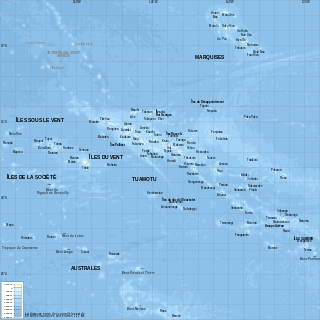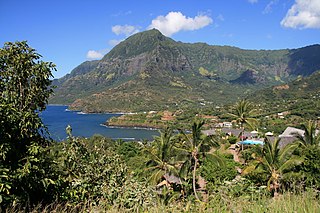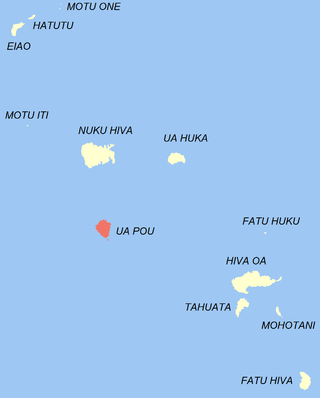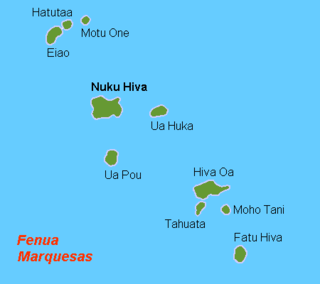Resources
- Handy, E. S. Craighill. The Native Culture in the Marquesas. Bernice Pauahi Bishop Museum Bulletin 9. B.P.B. Museum, Honolulu, 1971.
Nuku was a traditional province of the island of Hiva Oa in pre-European times. It did not function as a unified governmental unit, but rather as a confederation of local tribes during times of war with tribes from Hiva Oa's other province, Pepane. Nuku comprised approximately the western half of Hiva Oa's landmass, as well as the whole of the tribes of the neighboring island of Tahuata.

French Polynesia is located in Oceania. It is a group of six archipelagos in the South Pacific Ocean, about halfway between South America and Australia. Its area is about 4,167 km2, of which 3,827 km2 is land and 340 km2 is (inland) water. It has a coastline of 2,525 km but no land borders with other countries.

The Marquesas Islands are a group of volcanic islands in French Polynesia, an overseas collectivity of France in the southern Pacific Ocean. Their highest point is the peak of Mount Oave on Ua Pou island, at 1,230 m (4,035 ft) above sea level.
Marquesan is a collection of East-Central Polynesian dialects, of the Marquesic group, spoken in the Marquesas Islands of French Polynesia. They are usually classified into two groups, North Marquesan and South Marquesan, roughly along geographic lines.

With its 320 square kilometres, Hiva Oa is the second largest island in the Marquesas Islands, in French Polynesia, an overseas territory of France in the Pacific Ocean. Located at 9 45' south latitude and 139 W longitude, it is the largest island of the southern Marquesas group. Around 2,200 people reside on the island. A volcano, Temetiu, is Hiva Oa's highest point with 1,200 metres.

Atuona, located on Atuona Bay on the southern side of Hiva Oa island, French Polynesia, is the administrative centre of the commune (municipality) of Hiva-Oa. Atuona was the capital of all the Marquesas Islands but it has been replaced by Taioha'e.
Te Iʻi is a traditional province of Nuku Hiva, in the Marquesas Islands. The province covers slightly more than the western two-thirds of the island. The western coast is characterized by steep slopes which plunge directly into the sea, indented occasionally by small bays leading to short deep valleys leading to the interior.

Ua Pou is the third largest of the Marquesas Islands, in French Polynesia, an overseas territory of France in the Pacific Ocean.
Taʻa ʻOa is the South Marquesan name of a wide bay on the southern coast of Hiva ʻOa in French Polynesia. The bay is widely known in English as the Bay of Traitors, and in French as Baie des Traitres.

Temetiu is the South Marquesan name for the highest peak of the mountain ridge that rises above the western end of Ta'a Oa in southwestern Hiva ʻOa.
Atuona Bay is a small inlet on the north shore of Ta‘a ‘Oa, on the southern coast of Hiva ‘Oa. The bay is traditionally called Vevau in Marquesan.
Calvary Cemetery is the main cemetery in Atuona, Hiva ‘Oa, French Polynesia. It is located on a hillside on the eastern edge of town, overlooking the anchorage on Atuona Bay.
Ha‘ava is the Marquesan name of the 4 km (2.5 mi.) wide channel that separates Tahuata from Hiva Oa, in the southern Marquesas Islands. The French name for the passage is Canal du Bordelais.
Hanakee is the name of a small rocky islet lying off the southern coast of Hiva Oa, separating Atuona Bay from Taʻa ʻOa.

Tahuata is the smallest of the inhabited Marquesas Islands, in French Polynesia, an overseas territory of France in the Pacific Ocean. It is located 4 km (2.5 mi.) to the south of the western end of Hiva Oa, across the Canal du Bordelais, called Ha‘ava in Marquesan.

Ua Huka is one of the Marquesas Islands, in French Polynesia, an overseas territory of France in the Pacific Ocean. It is situated in the northern group of the archipelago, approximately 25 mi (40 km) to the east of Nuku Hiva, at 8°54′S139°33′W.

The red-moustached fruit dove or moustached fruit dove is an extinct species of bird in the family Columbidae. It was endemic to French Polynesia. The last record was of the subspecies P. m. tristrami on Hiva Oa, in 1922. Its extinction has been attributed to predation by the introduced great horned owl, as well as by introduced rats and cats. In 1994, it was listed as an extinct species on the International Union for Conservation of Nature Red List of Endangered Species.
The Marquesan monarch is a species of bird in the family Monarchidae. It is endemic to French Polynesia. Its natural habitats are subtropical or tropical dry forest, subtropical or tropical moist lowland forest, and subtropical or tropical moist montane forest. It is threatened by habitat loss.
Nuku is an element in a number of Polynesian placenames, as well as having a number of other uses. These include:

Nuku Hiva is the largest of the Marquesas Islands in French Polynesia, an overseas country of France in the Pacific Ocean. It was formerly also known as Île Marchand and Madison Island.

The Marquesan Dog or Marquesas Islands Dog is an extinct breed of dog from the Marquesas Islands. Similar to other strains of Polynesian dogs, it was introduced to the Marquesas by the ancestors of the Polynesian people during their migrations. Serving as a tribal totems and religious symbols, they were sometimes consumed as meat although less frequently than in other parts of the Pacific because of their scarcity. These native dogs are thought to have become extinct before the arrival of Europeans, who did not record their presence on the islands. Petroglyphic representations of dogs and the archaeological remains of dog bones and burials are the only evidence that the breed ever existed. Modern dog populations on the island are the descendants of foreign breeds later reintroduced in the 19th century as companions for European settlers.